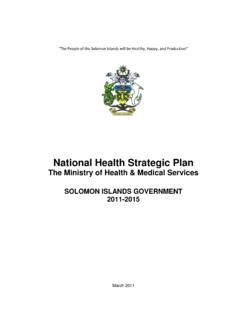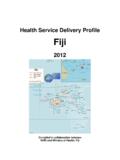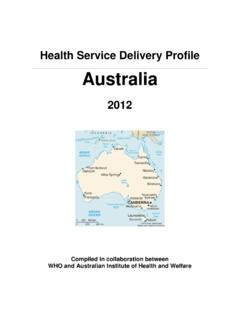Transcription of Acknowledgements - WPRO | WHO Western Pacific …
1 AcknowledgementsWHO Regional Office for the Western Pacific acknowledges the contributions made by Professor Phyllis J. watson to this Library Cataloguing in Publication Data Electronic Health Records: Manual for Developing Countries 1. Medical records systems, Computerized. 2. Manuals. 3. Developing countries. ISBN 92 9061 2177 (NLM Classification: WX 173) World Health Organization 2006 All rights designations employed and the presentation of the material in this publication do not imply the expression of any opinion whatsoever on the part of the World Health Organizationo concerning the legal status of any country, territory, city or area or of its authorities, or concerning the delimination of its frontiers or boundaries. Dotted lines on maps represent approximate border lines for which there may not yet be full mention of specific companies or of certain manufacturers products does not imply that they are endorsed or recommended by the World Health Organization in preference to others of a similar nature that are not mentioned.
2 Errors and omissions excepted, the names of proprietary products are distinguished by initial capital World Health Organization does not warrant that the information contained in this publication is complete and correct and shall not be liable for any damages incurred as a result of its of the World Health Organization can be obtained from Marketing and Dissemination, World Health Organization, 20 Avenue Appia, 1211 Geneva 27, Switzerland (tel: +41 22 791 2476; fax: +41 22 791 4857; email: Requests for permission to reproduce WHO publications, in part or in whole, or to translate them -- whether for sale or for noncommercial distribution -- should be address to Publication, at the above address (fax: +41 22 791 4806; email: For WHO Western Pacific Regional Publications, request for permission to reproduce should be addressed to Publications Office, World Health Organization, Regional Office for the Western Pacific , 2932, 1000, Manila, Philippines, Fax.))
3 No. (632 521-1036, email: named author/s alone is/are responsible for the views expressed in this RecordsA Manual for Developing CountriesElEctronic HEaltH rEcordsManual For developing countriesv CONTENTSC hapter 1: General Overview ..9 - Defining an Electronic Health Record (EHR) ..10 - Examples of EHR Practices ..13 Chapter 2: Preliminary Steps ..17 - Review of Current Health Record System ..17 - Review of Policies Relating to Medical Record Practice ..24 Chapter 3: Issues and Challenges ..27 Chapter 4: Planning for the Introduction of an EHR ..35 Chapter 5: Factors to be Considered when Developing an EHR Implementation Plan ..51 Chapter 6: Implementation Plan ..59 Annotated Bibliography ..65 Glossary of Terms ..73 ElEctronic HEaltH rEcordsManual For developing countriesvii Electronic Health Records: INTRODUCTIONB asic ConceptsThis manual has been designed as a basic reference for use when exploring the development and implementation of Electronic Health Record (EHR) systems.)
4 It provides a general overview, some basic definitions and examples of EHR practices. Also covered are points for consideration when moving towards the introduction of an EHR, some issues and challenges which may need to be addressed and some possible strategies, along with steps and activities to implementation. There is a particular focus on setting goals, revising policies, developing an action plan and outlining implementation procedures. Electronic health records are a complex issue and the following information is presented in a simple, concise and straight-to-the-point fashion, intended as an introductory reference for the topic. For those who want more detailed information there is a wealth of literature available if they wish to read more deeply on the subject. A Medline search was conducted and a short annotated bibliography has been Users of the ManualThis manual has been designed with the following persons in mind: Ministry of Health staff at national and provincial or district health centre levels actively involved in exploring the development of electronic health records.
5 People who do not have an in-depth knowledge of EHR and who need a general overview, particularly if they are members of a multi-disciplinary committee tasked with investigating the introduction of an EHR. Health record managers/administrators who are responsible for the medical/health record and record services at primary and secondary levels of care in developing the ManualIt is important that the reader treats this manual not as a set of definitive rules applicable in every situation, as each institution/country have different needs and requirements, but as a guide to help ensure that some important ElEctronic HEaltH rEcordsManual For developing countriesviiiactivities and issues have been considered and addressed before proceeding with the task of developing and implementing an StructureThe text has been divided into six chapters. The first chapter deals with a general overview, basic EHR definitions and some examples of EHR practices.
6 Chapter 2 covers some preliminary steps required prior to developing a plan for implementation. Chapter 3 covers issues and challenges which need to be identified and addressed. Chapter 4 deals with planning for the introduction of an EHR and includes perceived benefits, setting goals, developing strategies and preparing policies and procedures. Chapter 5 covers factors to be considered when developing an implementation plan and Chapter 6 deals with implementation. The above chapters are followed by an annotated bibliography and a glossary of HEaltH rEcordsManual For developing countries CHAPTER 1 General Overview With the many advances in information technology over the past 20 years, particularly in healthcare, a number of different forms of electronic health records (EHR) have been discussed, developed, and implemented. Some institutions/countries are currently planning the introduction of a nationwide electronic health record while others have actually implemented some form of EHR.
7 However, the type and extent of electronic health records vary and what one country calls an EHR may not be the same as that developed in another country. Although work has been undertaken by institutions/countries on some form of a computerised patient healthcare information system, as yet not many hospitals have successfully introduced an electronic health record with clinical data entry at the point of care. Although interest in automating the health record is generally high in both developed and developing countries unfortunately, in some cases, the introduction of an EHR system seems overwhelming and almost out of reach to many healthcare providers and administrators as well as medical record/ health information managers. Why is this so? The obstacles may not be available technology but technical support and the cost of changing to an electronic system coupled with insufficient healthcare funding.
8 In many developing countries costs, available technology, lack of technical expertise and computer skills of staff, and lack of data processing facilities are in fact major issues which would need to be addressed before implementation is possible. In addition to the above, resistance by some medical practitioners and health professionals generally to a change from manual to electronic documentation may be a problem in both developed and developing countries. Most health administrators and information managers are aware that it may take time to change or at least modify health practitioner behaviour and reason for wanting to change to an electronic system is important. Many persons involved in healthcare today expect to move from a paper to a paperless environment. This is a major step and has only been successfully achieved in a few healthcare institutions to date. Institutions should not focus on just going paperless.
9 They should focus on encouraging departments and healthcare practitioners to move to an electronic system to: Improve the accuracy and quality of data recorded in a health record Enhance healthcare practitioners access to a patient s healthcare information enabling it to be shared by all for the present and continuing care of that patientElEctronic HEaltH rEcordsManual For developing countries10 Improve the quality of care as a result of having health information immediately available at all times for patient care Improve the efficiency of the health record service Contain healthcare costs A paperless environment will in some instances there is a tendency to expect that with the introduction of an electronic health record many of the problems currently experienced in maintaining paper health records will be eliminated. This is not the electronic health record is not a simple replacement of the paper record.
10 If identified problems are not addressed and remedied prior to introducing an EHR system merely automating health record content and procedures may perpetuate deficiencies and not meet the EHR goals of the institution/country. Current problems identified in healthcare documentation, as well as privacy and confidentiality issues must be addressed and quality control measures introduced before a successful change can be implemented. Although the introduction of a fully electronic health record system may seem far off in many healthcare institutions/countries they are being introduced rapidly in others and there is no doubt that the future of health information management lies with automation and the automatic transmission of information required for patient management at all levels of an Electronic Health RecordAs mentioned above when people refer to what they have been using as an electronic health record, it may not be the same as other electronic health records developed in different institutions/countries.









